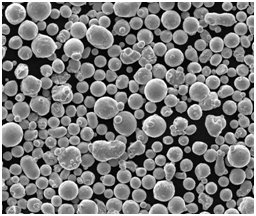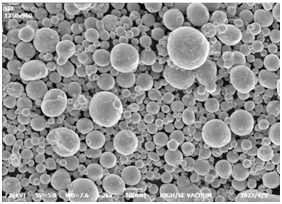개요 전자빔 선택적 용융 장비
전자빔 선택적 용융(EBSM)은 전자빔을 사용하여 금속 분말을 층별로 선택적으로 용융하여 복잡한 3D 구조를 만드는 첨단 적층 제조 기술입니다. 이 기술은 특히 우수한 강도, 정밀도 및 재료 무결성이 요구되는 고성능 재료 및 애플리케이션에 적합합니다. 이 종합 가이드에서는 EBSM의 세부 사항을 살펴보고, 이 공정에 사용되는 다양한 금속 분말 모델을 살펴보고, 장비, 특성, 응용 분야 및 공급업체에 대한 자세한 정보를 제공합니다.
전자빔 선택적 용융이란 무엇인가요?
EBSM은 금속 분말 층에 전자 빔을 쏘아 금속 분말을 녹여 서로 융합시키는 공정입니다. 이 과정은 최종 3D 물체가 완성될 때까지 레이어별로 반복됩니다. 다른 적층 제조 방식과 달리 EBSM은 뛰어난 정밀도와 재료 특성을 제공하므로 항공우주, 자동차, 의료용 임플란트와 같은 핵심 산업에 이상적입니다.
전자빔 선택적 용융 장비의 주요 특징
- 높은 정밀도: EBSM은 전자 빔의 미세 제어를 통해 높은 정확도와 복잡한 디테일을 구현합니다.
- 소재의 다양성: 다양한 금속 분말을 처리할 수 있습니다.
- 뛰어난 기계적 특성: 생산된 부품은 뛰어난 강도와 내구성을 자랑합니다.
- 잔여 스트레스 감소: 이 프로세스는 최종 제품의 내부 스트레스를 최소화합니다.
- 효율적인 재료 사용: 낭비를 최소화하면서 재료 사용률을 높입니다.

전자빔 선택적 용융을 위한 금속 분말의 종류
금속 분말의 선택은 최종 제품의 품질과 특성에 직접적인 영향을 미치기 때문에 EBSM에서 매우 중요합니다. 여기에서는 특정 금속 분말 모델을 나열하고 그 구성과 특성을 설명합니다.
EBSM용 인기 메탈 파우더 모델
- Ti-6Al-4V(티타늄 합금)
- 구성: 6% 알루미늄, 4% 바나듐, 균형 티타늄
- 속성: 높은 중량 대비 강도, 우수한 내식성, 생체 적합성
- 애플리케이션: 항공우주 부품, 의료용 임플란트
- 인코넬 718(니켈-크롬 합금)
- 구성: 니켈 50-55%, 크롬 17-21%, 철, 콜럼븀, 몰리브덴
- 속성: 고온 강도, 내산화성, 우수한 용접성
- 애플리케이션: 터빈 블레이드, 로켓 엔진, 원자로
- AlSi10Mg(알루미늄 합금)
- 구성: 10% 실리콘, 0.3% 마그네슘, 균형 알루미늄
- 속성: 가볍고 우수한 열적 특성, 우수한 중량 대비 강도 비율
- 애플리케이션: 자동차 부품, 항공우주 부품, 경량 구조물
- 316L 스테인리스 스틸
- 구성: 철, 16-18% 크롬, 10-14% 니켈, 2-3% 몰리브덴
- 속성: 높은 내식성, 우수한 연성, 우수한 기계적 특성
- 애플리케이션: 의료 기기, 화학 처리 장비, 해양 애플리케이션
- CoCr(코발트-크롬 합금)
- 구성: 60% 코발트, 27-30% 크롬, 균형 몰리브덴, 니켈
- 속성: 높은 내마모성, 우수한 내식성, 생체 적합성
- 애플리케이션: 치과용 임플란트, 정형외과용 임플란트, 항공우주 부품
- 마레이징 스틸
- 구성: 18% 니켈, 8-12% 코발트, 균형 철분
- 속성: 초고강도, 우수한 인성, 우수한 용접성
- 애플리케이션: 툴링, 항공우주 부품, 고강도 애플리케이션
- 하스텔로이 X(니켈-크롬-몰리브덴 합금)
- 구성: 니켈, 20-23% 크롬, 8-10% 몰리브덴, 1.5-2.5% 코발트
- 속성: 우수한 고온 강도, 산화 저항성
- 애플리케이션: 가스터빈 엔진, 화학 처리, 열교환기
- 니오븀
- 구성: 순수 니오븀
- 속성: 높은 융점, 우수한 내식성, 우수한 생체 적합성
- 애플리케이션: 초전도체, 의료 기기, 항공우주 부품
- 구리
- 구성: 순수 구리
- 속성: 우수한 전기 및 열 전도성, 우수한 연성
- 애플리케이션: 전기 부품, 열교환기, 라디에이터
- 공구강
- 구성: 다양함(일반적으로 탄소, 크롬, 바나듐, 몰리브덴 포함)
- 속성: 높은 경도, 우수한 내마모성, 우수한 인성
- 애플리케이션: 절삭 공구, 금형, 금형
의 특성 전자빔 선택적 용융 장비
EBSM 장비는 적층 제조에서 높은 정밀도와 효율성을 제공하도록 설계되었습니다. 다음은 이 장비의 몇 가지 필수적인 특징입니다:
주요 구성 요소
- 전자 빔 건: 높은 정밀도로 전자빔을 생성하고 방향을 지정합니다.
- 회의실 구축: 빌드 영역을 둘러싸고 진공 또는 불활성 대기를 유지합니다.
- 파우더 디스펜서: 빌드 영역 전체에 금속 파우더를 균일하게 분배합니다.
- 리코터 블레이드: 각 층의 파우더를 부드럽게 펴 바릅니다.
- 제어 시스템: 전자빔 및 빌드 프로세스의 파라미터를 관리합니다.
주요 특징
| 특징 | 설명 |
|---|---|
| 빌드 크기 | 일반적으로 하나 이상의 치수가 작은 크기(100mm)에서 큰 크기(1000mm)까지 다양합니다. |
| 해상도 | 레이어 두께가 20~100마이크로미터에 이르는 고해상도. |
| 전력 요구 사항 | 수 킬로와트 범위의 상당한 전력을 필요로 하는 경우가 많습니다. |
| 분위기 제어 | 진공 또는 불활성 가스(아르곤 등)를 사용하여 산화와 오염을 방지합니다. |
| 소프트웨어 통합 | 설계, 시뮬레이션 및 제어를 위한 고급 소프트웨어로 CAD 모델을 정확하게 준수할 수 있습니다. |
| 냉각 시스템 | 효율적인 냉각 시스템으로 녹는 과정에서 발생하는 열을 관리합니다. |
| 재료 호환성 | 티타늄, 알루미늄, 스테인리스 스틸, 니켈 기반 초합금 등 다양한 금속 분말을 가공할 수 있습니다. |






전자빔 선택적 용융 장비의 응용 분야
EBSM 기술은 다양한 산업 분야에서 다용도로 사용되고 있습니다. 다음은 몇 가지 일반적인 애플리케이션입니다:
산업용 애플리케이션
| 산업 | 애플리케이션 |
|---|---|
| 항공우주 | 엔진 부품, 구조 부품, 복잡한 형상, 경량 소재 |
| 자동차 | 엔진 부품, 맞춤형 구성 요소, 경량 구조 |
| 의료 | 정형외과 임플란트, 치과 임플란트, 수술 기구 |
| 에너지 | 터빈 블레이드, 열교환기, 원자로 구성품 |
| 방어 | 경량 갑옷, 무기 부품, UAV 부품 |
| 툴링 | 금형, 금형, 절삭 공구 |
| 전자 제품 | 방열판, 전기 부품, 커넥터 |
자세한 애플리케이션
- 항공우주 부품: EBSM은 가볍고 복잡한 항공우주 부품을 제조하는 데 사용되어 재료 낭비를 줄이고 성능을 향상시킵니다.
- 의료용 임플란트: 생체 적합성 재료로 복잡한 디자인을 제작할 수 있는 EBSM은 맞춤형 임플란트 제작에 이상적입니다.
- 자동차 부품: 고성능 경량 부품을 제작하여 차량의 연비와 성능을 향상시킬 수 있습니다.
- 에너지 부문: 터빈 블레이드와 열교환기는 EBSM 생산 부품의 높은 강도와 내열성의 이점을 누릴 수 있습니다.
- 툴링: 정밀 금형과 금형은 뛰어난 내구성과 내마모성으로 제작됩니다.
다음에 대한 사양 및 표준 전자빔 선택적 용융 장비
품질과 일관성을 보장하기 위해 EBSM 장비는 특정 사양과 표준을 준수해야 합니다.
EBSM 장비 사양
| 사양 | 설명 |
|---|---|
| 볼륨 구축 | 가변, 일반적으로 200 x 200 x 200mm ~ 700 x 700 x 400mm |
| 레이어 두께 | 20-100 마이크로미터 |
| 빔 파워 | 3~10kW |
| 스캔 속도 | 최대 8m/s |
| 해상도 | ± 0.1 mm |
| 분위기 제어 | 진공 또는 불활성 가스(예: 아르곤) |
| 소프트웨어 | 실시간 모니터링 및 제어 기능을 갖춘 통합 CAD/CAM 소프트웨어 |
EBSM 장비 표준
| 표준 | 설명 |
|---|---|
| ASTM F3187 | 전자빔 용융 적층 제조 공정 표준 가이드 |
| ISO/ASTM 52900 | 적층 제조 표준 용어 |
| ISO 13485 | 의료 기기 품질 관리 시스템 |
| AS9100 | 항공 우주를 위한 품질 관리 시스템 |
| ISO 9001 | 일반 품질 관리 표준 |
공급업체 및 가격 세부 정보
EBSM 장비를 소싱할 때는 평판이 좋은 공급업체를 고려하고 가격을 비교하는 것이 중요합니다.
공급업체 목록 및 가격
| 공급업체 | 장비 모델 | 가격 범위 | 연락처 정보 |
| Arcam(GE 애디티브) | Arcam EBM Q10plus | $500,000 – $1,000,000 | www.ge.com/additive |
| Sciaky Inc. | EBAM 300 시리즈 | $1,000,000 – $2,500,000 | www.sciaky.com |
| Renishaw | RenAM 500E | $600,000 – $1,200,000 | www.renishaw.com |
| 프리멜트 | 프리멜트 ONE | $400,000 – $800,000 | www.freemelt.com |
| 첨가제 산업 | MetalFAB1 | $800,000 – $1,500,000 | www.additiveindustries.com |
| Xi’an 밝은 레이저 | EP-M250 | $500,000 – $1,000,000 | www.xbmetal.com |
| 에어로신트 | 멀티 머티리얼 EBM | $700,000 – $1,400,000 | www.aerosint.com |
| 3D Systems | DMP Flex 350 | $500,000 – $1,200,000 | www.3dsystems.com |
| 트럼프 | TruPrint 3000 | $700,000 – $1,300,000 | www.trumpf.com |
| EOS | EOS M 290 | $600,000 – $1,100,000 | www.eos.info |
전자빔 선택적 용융의 장단점 비교
EBSM에는 뚜렷한 장점과 몇 가지 한계가 있습니다. 여기에서는 이 두 가지를 비교하여 균형 잡힌 관점을 제공합니다.
EBSM의 장점과 단점
| 측면 | 장점 | 단점 |
|---|---|---|
| 정밀도 | 높은 정확도와 복잡한 디테일 | 정밀한 제어 및 모니터링 필요 |
| 머티리얼 속성 | 우수한 기계적 특성, 잔류 응력 감소 | 전자빔 처리와 호환되는 재료로 제한됩니다 |
| 빌드 속도 | 다른 적층 제조 방식에 비해 빌드 시간 단축 | 매우 큰 부품의 경우 속도가 느려질 수 있습니다 |
| 재료 효율성 | 낭비를 최소화하면서 높은 재료 활용도 | 분말 처리 및 재활용은 복잡할 수 있습니다 |
| 운영 비용 | 고부가가치 및 복잡한 부품에 비용 효율적 | 높은 초기 투자 및 운영 비용 |
| 복잡성 | 매우 복잡한 지오메트리 생성 가능 | 설계 및 프로세스 매개변수에 대한 전문 지식 필요 |
| 후처리 | 일반적으로 다른 방법에 비해 후처리가 덜 필요합니다 | 일부 부품은 여전히 기계 가공과 같은 마감 공정이 필요할 수 있습니다 |
| 다용도성 | 항공우주부터 의료까지 다양한 분야에 적합 | 비금속 소재에는 적합하지 않음 |
| 분위기 제어 | 제어된 분위기로 산화 없이 고품질 부품 보장 | 진공 또는 불활성 대기를 유지하는 것은 기술적으로 까다로울 수 있습니다 |
참여도 향상을 위한 단락 구조 최적화
EBSM과 같은 기술적인 주제에 대해 글을 쓸 때는 독자의 참여를 유도하는 것이 중요합니다. 이를 효과적으로 수행하는 방법을 살펴보겠습니다.
대화체 톤과 매력적인 스타일 사용
저녁 파티에서 3D 프린팅에 대해 궁금해하는 친구에게 EBSM에 대해 설명한다고 상상해 보세요. 기술 전문 용어로 바로 뛰어들지는 않겠죠? 대신 "제트 엔진의 매우 복잡한 부품을 어떻게 만드는지 궁금한 적이 있나요?"와 같이 친근한 질문부터 시작할 것입니다 전자빔 선택적 용융이라는 놀라운 기술이 있습니다...”>이라고 합니다;
복잡한 정보를 이해하기 쉬운 덩어리로 나누고 비유, 은유, 수사학적 질문을 사용하여 독자의 관심을 유지합니다. 예를 들어, EBSM의 정밀도를 설명하는 것을 '크레용과 펜으로 그림을 그리는 것과 전자빔이 펜이 되어 섬세한 디테일과 부드러운 가장자리를 제공하는 것'에 비유할 수 있습니다;

자주 묻는 질문
| 질문 | 답변 |
|---|---|
| EBSM과 함께 사용할 수 있는 자료에는 어떤 것이 있나요? | EBSM은 티타늄 합금, 니켈 기반 초합금, 알루미늄 합금, 스테인리스강, 코발트-크롬 합금 등 다양한 금속 분말을 처리할 수 있습니다. |
| EBSM은 다른 3D 프린팅 방식과 어떻게 다른가요? | EBSM은 SLM(선택적 레이저 용융) 또는 DMLS(직접 금속 레이저 소결)와 같은 방식에 비해 우수한 기계적 특성, 정밀도 및 잔류 응력 감소 효과를 제공합니다. |
| EBSM의 일반적인 적용 분야는 무엇인가요? | 일반적인 애플리케이션으로는 항공우주 부품, 의료용 임플란트, 자동차 부품, 에너지 부문 부품, 툴링 등이 있습니다. |
| EBSM은 대량 생산에 적합한가요? | EBSM은 정밀도와 재료 효율성으로 인해 일반적으로 대량 생산보다는 고부가가치 복잡한 부품에 사용됩니다. |
| EBSM 부품에는 어떤 후처리가 필요하나요? | 애플리케이션에 따라 EBSM 부품은 원하는 마감과 특성을 얻기 위해 기계 가공, 연마 또는 열처리와 같은 최소한의 후처리가 필요할 수 있습니다. |
결론
전자빔 선택적 용융은 적층 제조의 획기적인 발전을 의미합니다. 복잡한 고성능 부품을 정밀하고 효율적으로 제작할 수 있는 이 기술은 다양한 산업 분야에서 매우 유용합니다. 금속 분말의 종류, 장비의 특성, 다양한 응용 분야를 이해하면 EBSM 기술의 혁신적 잠재력을 이해할 수 있습니다. 엔지니어, 제조업체 또는 단순히 기술 애호가 모두에게 EBSM의 세계는 한 번에 하나의 전자빔을 제조하는 미래를 만들어가는 가능성으로 가득합니다.

